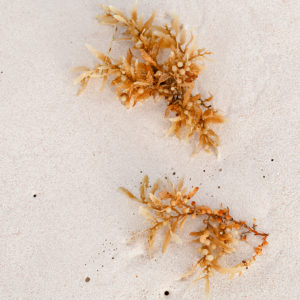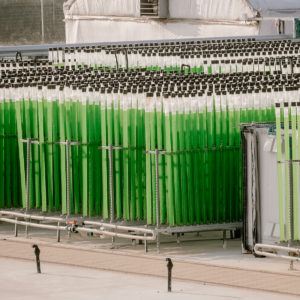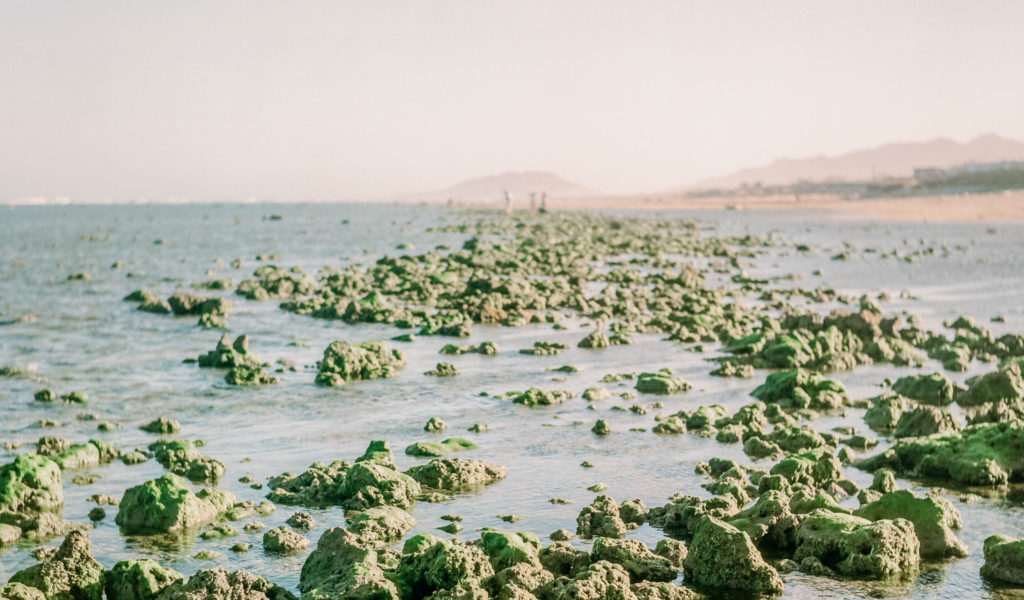Algae is a natural, sustainable material with a deal more strings to its bow than as a sushi wrapping. Algae has emerged as a viable alternative to fossil-fuel derived goods and materials including energy, plastics, cosmetics and more.
But not only are the commercial applications for algal biomass wide ranging, with innovative new uses emerging all the time, the material holds a significant advantage over sustainable land crops like cornstarch, bamboo, or hemp, in that its scaled production does not wrest land from important food crops. There are strong indicators that algae is going to play a very important role in reducing our reliance on fossil fuel-derived materials; not least the fact that the US algae market is expected to grow from just over $2bn today to over $4bn in the next ten years.
Algae eminently renewable, it grows so quickly under the right circumstances that it can be considered a practically infinite raw material – a fact that many startups and commercial enterprises are mining for advantage already. Its extreme versatility is a boon of the hundreds of thousands of species that fall within the category, and explains why algae has come to be associated with everything from food supplements and biodiesel, to kelp clothing and biodegradable food packaging.

What is Algae?
Seaweed is a macroalgae, a multicellular organism that you can spot on the sea shore (we can include kelp under this heading too) but the broader category of “algae” also includes what is called microalgae. These are unicellular organisms, invisible to the naked eye but essential to a balanced ecosystem on earth.
Both macroalgae and microalgae have broad applications as sustainable materials. They live by photosynthesis, drawing in energy from the sun and generating valuable proteins, fats and carbohydrates with it. Microalgae, the invisible kind, make up almost 50% of the world’s “primary production”, which refers to anything that becomes food for another organism without consuming organisms itself.
Microalgae can be cultivated in open or closed containers of saltwater or brackish water, and harvested relatively simply to make biomass, which is turn ready for a range of uses. Because microalgae don’t have roots and stems like land crops do, they use energy more efficiently and can grow far more rapidly; a significant advantage over other sustainable materials seeking to topple petroleum-based plastic from its global throne.
How Is Algae Used?
Food
Like other sustainable materials, algae has a wide range of applications, though perhaps the most obvious is as a food supplement. With our growing awareness of the unsustainability of the meat and fish industries rising everyday, and population growth expected to force an eye-watering 50% hike in food production over the next 50 years, new and sustainable sources of protein are goldust. Luckily, edible algae contains all of the proteins, carbohydrates, vitamins, and minerals that we rely on for good health and can even be considered a complete food. It also has medical value due to its antioxidant, anticancer and antiviral properties.
Animal Feed
Many of the same nutritional benefits to humans mean that algae can be an equally valuable and cost effective supplementary input in the composition of animal feed. The fatty acids, amino acids, carotenoids and vitamins found in macroalgae (e.g. seaweed) have seen its use in domestic animal and poultry feed become commonplace. But according to recent studies, microalgae too can be incorporated into traditional animal feed, with gains to livestock health and product end quality. A scaled-up microalgae industry looks like a far more sustainable alternative to the global soybean crop (75% of which is used in animal feed), which has brought great strain to forests and natural habitats in Brazil and beyond.
Bioplastics
Seaweed and the wider algal family are perhaps best known among consumers as an alternative material to petroleum-based plastics in the manufacture of everyday disposable items like cups and straws. Biodegradable is an overused, and sometimes misused term when it comes to sustainable materials. Many bioplastics are compostable only through industrial facilities that are not serviced by curbside municipal collections. Algae products and packaging differ in that they can be manufactured so as to be fully compostable at home in the backyard, or even edible (imagine tossing the wrapping into the pot with your noodles). And because algae captures carbon during growth, the net emissions after its eventual biodegradation are almost zero. Biomass derived from algae also has the potential to be less energy intensive to manufacture and utilize fewer chemicals to extract its usable elements. Nor does it strictly require the use of fertilizer to grow in abundance. With these defining features, the life cycle of algae-derived bioplastics presents key advantages over other natural materials.
Algae Biofuel
Algae was pipped as an extremely promising biofuel source that hasn’t yet lived up to expectation. This is primarily due to the difficulty in farming and producing it at a competitive price relative to oil. While its high- lipid content suggests it could easily outperform other biofuel crops to produce diesel, synthetic petroleum, butanol and ethanol, the reality has proved hard to realize. So while a number of advantages over land-based crops exist, it is still proving difficult to bring algae based biofuel to the mass market.
Textiles
Algae is being developed into bio-textiles by various forward-thinking companies. The key advantage of algae as a sustainable clothing fiber is that it requires lower agricultural land use as compared to traditional textiles like cotton. It also eliminates cotton’s massive thirst for freshwater; algae fibers require 80% less water than the equivalent cotton fibers would. Furthermore it can be farmed in indoor, “closed farms” as in the case of Israel’s Algatech, whose solar powered plant can be situated to best serve their supply chain. Another nearby Israeli outfit, Algaeing, uses their proprietary process to convert Algatech’s product into a liquid which can be combined with cellulose (from plants) to make a durable textile or used as a chemical-free dye. In another strand of new products, kelp, a macroalgae, is being used by the company Algiknit to manufacture a durable yarn for clothing.
 Is Algae A Sustainable Material?
Is Algae A Sustainable Material?
Both macroalgae and microalgae are sustainable materials and are highly renewable. They can be farmed in open or closed containers with no impact on the naturally occurring algae that maintains our aquatic ecosystems. Algae production avoids nutrient leakage and water pollution associated with crops fulfilling similar functions. And algae naturally sequesters carbon during growth that cancels out emissions during decomposition, making it a valuable crop in the fight against climate change.
There are developments showing that protein-rich strains of algae can be grown on waste resources such as the nitrogen digestate resulting when food waste is processed into bioenergy. These efforts to close the loop of the circular economy by reducing waste where possible and harnessing it as feedstock where possible, show that algae has the potential to be a highly synergistic and sustainable crop.
In the realm of packaging, a number of companies are producing food packaging that is not only biodegradable, but edible, meaning that the ease and probability of ensuring zero waste in the product’s lifecycle is high.
What Are The Benefits of Algae?
Algae offers a number of important benefits as a sustainable material but these are the standout talking points.
It can be grown anywhere
One of the great advantages of algae, and a key differentiator with other renewable crops, is that it can be grown almost anywhere in open or closed containers, and need not usurp land intended for essential food crops. In theory, all it needs is water and sunlight.
Non-toxic
Algae can be processed without chemicals and fertilizers, thus avoiding chemical leakage into surrounding ecosystems that fertilized crops incur.
Rapidly renewable
Algae grows very fast and can renew almost infinitely. The US Department of Energy found that algae could yield around 30 times more energy than other land-based biomass crops.
Large number of species
The large number of species, over 100,000 means that algae can be cultivated toward an almost infinite number of genetic combinations for myriad applications.
What Are The Disadvantages Of Algae?
Algae has turned out to be less of a natural successor to fossil fuel energy than many hoped, proving more feasible for nutraceuticals and food supplements than powering car engines. One of the main problems has been preserving open water containers from disruption from without. This phenomenon, known as pond crash, can cause the rapid destruction of a whole crop of algae in days.
A connected worry is that monocropping could result in devastating disruptions to algae supply chains. In other words, when the industry focuses on one highly successful strain of algae it becomes proportionally more vulnerable to wholesale failures of that strain from targeted pests, pollution or disease.
Though prolific in terms of growth speed and yield, algae is also a fragile crop, sensitive to small changes in heat, light, pH balance, and more. And while algae can feed on unwanted CO2 and wastewater, supplying this is not always the smooth, cost effective and synergistic process we’d like to envisage. In fact it is often prohibitively expensive. All this adds up to a great challenge for growers in producing a consistent product.
While algae can be grown in closed tanks to protect from many harmful outside influences, it must be noted that this detracts from the sustainability of the overall product. And even if we discount the environmental criteria, the cost also mounts higher in closed tank farms. making it a tougher sell.
Although algae can grow without fertilizer, it is the case that fertilizer can and is used to spur faster growth and higher yields. And with this reality come the appendant dangers to surrounding ecosystems we recognize from other crops.
As with biofuel, so with textiles; algae fibers are currently more expensive than conventional fibers like cotton and until their production is scaled up the cost incentive to use more traditional, unsustainable fibers will prevail.
How Else Can Algae Be Used?
Though most lauded for its use in bioplastics and its superlative value in human food supplements and animal feed, we may only be seeing the tip of the iceberg for algae.
Cosmetics
A completely chemical free sunscreen is being developed by Icelandic company Taramar. A sunscreen that offers UV protection and harnesses the powerful antioxidant property in algae but which also manages to eschew the harmful chemicals used in most big brand cosmetics.
Carbon Fiber
A German company called SGL Carbon is in the process of developing an algae-based carbon fiber which could function identically to the original, oil-based material.
Bio-Ink
Heavy metals such as lead or mercury may be present in the printer ink you use at home or in the office, the extraction of which racks up significant carbon emissions. A startup called Living Ink Technologies is harnessing the environmental benefits of algae to make an entirely non-toxic, sustainable ink that can slot into your current printers.
Treating Wastewater
Adding algae into the process of treating wastewater effluent from things like tanneries, canned fish and meat processing could increase cost efficiency up to 25%, making the process viable for smaller businesses.
The sustainability credentials of algae are significant and it differs from other sustainable materials spearheading a shift away from traditional fossil fuels in that it doesn’t threaten food crops. But however much algae promises for bioplastics, nutraceuticals and food supplements, it has fallen short in biofuel. The prohibitively high cost of production ensures that proliferation is still far in the future. Indeed, the Office of Energy Efficiency and Renewable Energy does not hope to hit affordable pricing levels before 2030. Despite its patchwork use across sectors, the ability of algae to produce truly biodegradable products and make waste disposal circular is a valuable step towards the circular economy. One which we must aim for if we are to avoid catastrophic climate change.
Visit the zero waste blog for more tips and guides on going zero waste, or check out the shop to see what sorts of products are making clever use of zero waste raw materials.

